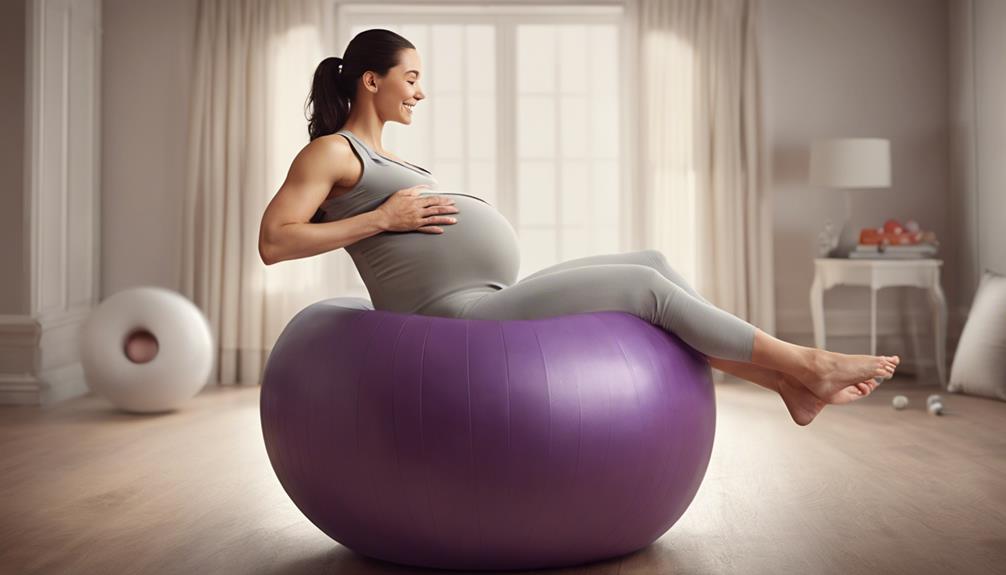As we approach the final stages of pregnancy, let’s view the birthing ball as our trusted companion, assisting us in staying active and preparing for what lies ahead.
With its gentle yet effective movements, this versatile tool holds the potential to revolutionize our approach to fitness during the third trimester.
But what specific benefits can these exercises offer, and how can they contribute to our overall well-being as we progress towards labor and delivery?
Let's explore together how incorporating pregnancy ball exercises can be a game-changer in our prenatal routine.
Key Takeaways
- Enhance strength, flexibility, and balance for a healthier pregnancy.
- Support body for labor, improve posture, and reduce discomfort.
- Focus on pelvic floor strength and core stability for birthing preparation.
- Reduce back pain, promote better posture, and prepare for labor with targeted exercises.
Benefits of Pregnancy Ball Exercises
Engaging in pregnancy ball exercises during the third trimester can greatly enhance strength, flexibility, and balance while reducing discomfort and preparing the body for labor. These exercises, performed with a stability ball, target key muscles such as the core muscles and pelvic floor. By incorporating the ball into your routine, you can effectively engage your lower body muscles, promoting better posture and alignment as your body undergoes significant changes. Strengthening the core muscles not only helps in supporting the growing belly but also aids in relieving back pain commonly experienced during pregnancy.
Additionally, focusing on the pelvic floor muscles through pregnancy ball exercises can help alleviate pelvic pressure and prepare these muscles for the birthing process. As you move through the third trimester, these exercises become increasingly important for maintaining overall body strength and stability. Regular practice of these exercises can contribute to a smoother labor and delivery, making them a valuable addition to your prenatal fitness routine.
Safety Tips for Third Trimester Workouts

As you progress into the third trimester of pregnancy, it is important to prioritize safety in your workouts to make sure the well-being of both you and your baby. In this stage, focusing on exercises that support your changing body is vital. Avoid activities that require lying on your back to prevent pressure on the vena cava, opt for gentle movements to reduce the risk of injury, and stay hydrated while listening to your body's signals to prevent overexertion.
Here are some safety tips to keep in mind during your third trimester workouts:
| Safety Tips for Third Trimester Workouts |
|---|
| Avoid exercises requiring lying on your back |
| Focus on gentle movements and avoid high-impact activities |
| Stay hydrated and listen to your body's signals |
| Use proper form and technique for stability |
| Consult with your healthcare provider before starting any new routine |
Top Pregnancy Ball Exercises to Try
Incorporate pregnancy ball exercises into your routine during the third trimester to enhance strength and flexibility, supporting your body for labor and promoting better posture. These exercises are beneficial for preparing your body for childbirth by focusing on pelvic floor strength and core stability. Best fetal positioning can also be encouraged through the use of a birthing ball, potentially leading to a smoother delivery experience.
Additionally, engaging in pregnancy ball exercises can help reduce discomfort, improve posture, enhance circulation, and decrease swelling during the final stages of pregnancy. Some top pregnancy ball exercises to try include gentle bouncing while sitting on the ball to promote pelvic mobility, pelvic tilts to strengthen the core and pelvic muscles, and circular hip movements to relieve tension and encourage flexibility.
Modifications for Comfort and Effectiveness

To guarantee comfort and effectiveness during the third trimester, it's important to make modifications to pregnancy ball exercises that accommodate the growing belly and changing center of gravity. Pregnant women should adjust the range of motion and intensity of movements to ensure safety.
Focus on stability and balance while performing exercises on the ball to prevent falls or strains. Incorporating additional support, such as pillows or cushions, can help maintain proper alignment and reduce strain on the body.
It's vital to listen to your body and stop any exercise that causes discomfort or pain while using the pregnancy ball in the third trimester. By making these modifications, pregnant women can continue to stay active and prepare for labor while keeping their comfort and well-being a top priority.
Preparing for Labor With Exercise Ball Routines
Enhance your labor preparation and strengthen key muscles with targeted exercise ball routines in the third trimester. These exercises play an important role in getting your body ready for the birthing process by focusing on core muscles, pelvic floor strength, and best fetal positioning. By incorporating movements like pelvic tilts, squats, hip circles, and kegels on the exercise ball, you can effectively support your body for labor while reducing discomfort in the lower back and hips. Regular practice of these routines aids in alleviating back pain, enhancing spine flexibility, and promoting overall well-being during pregnancy. The use of an exercise ball during the third trimester not only helps with physical preparation but also encourages relaxation and the baby's descent in the birth canal. Embrace these exercises as a way to connect with your body and your baby while getting ready for the beautiful journey of childbirth.
| Exercise | Benefits | Frequency |
|---|---|---|
| Pelvic Tilts | Strengthen core muscles, reduce back pain | Daily |
| Squats | Promote best fetal positioning | 3 times a week |
| Hip Circles | Improve flexibility in the hips | Every other day |
| Kegels | Enhance pelvic floor strength | Throughout the day |
Frequently Asked Questions
How Do You Prepare for Labor With a Ball?
We prepare for labor with a ball by practicing pelvic tilts, hip circles, squatting for lower body strength, stretching for flexibility, deep breathing for relaxation, and Kegel exercises for pelvic floor strength. These exercises help us stay active and ready for labor.
When Should I Start Bouncing on My Ball in Third Trimester?
We start bouncing on the ball in the third trimester for benefits like back pain relief, fetal positioning, and preparing for labor. It helps with circulation, swelling, pelvic floor strength, and relaxation. It's a game-changer!
How Do You Use an Exercise Ball in the Third Trimester?
In the third trimester, we use an exercise ball for relieving back pain, strengthening core muscles, and enhancing flexibility. Engage in hip circles, pelvic tilts, and pelvic floor exercises to prepare for labor, staying active and ready for childbirth.
How Do You Dilate Your Cervix With an Exercise Ball?
We can't directly dilate the cervix with an exercise ball. However, gentle movements may support best fetal positioning, relaxation, and pelvic alignment, potentially aiding the body's natural processes during labor. Consult healthcare providers for personalized guidance.
Conclusion
To sum up, pregnancy ball exercises in the third trimester are a fantastic way to stay active and prepare for labor.
So grab your ball, get moving, and feel the burn… or maybe just the gentle stretch.
Remember, it's all about staying comfortable and healthy, even if that means waddling instead of walking.
Keep up the great work, mama-to-be!










